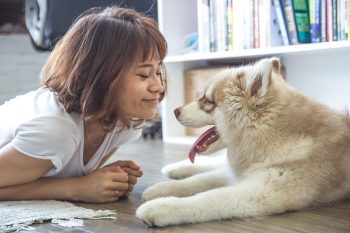As our canine companions enter their golden years, their needs evolve, requiring adjustments to their living environment to ensure their continued comfort and well-being. The term “dog owner” seems inadequate to describe the deep, nurturing bond that develops over the years with our beloved pets. Instead, “dog guardian” or “dog parent” more accurately reflects the proactive and caring approach required in looking after an aging dog. These terms highlight the responsibility and affection involved in caring for a pet who has been a loyal friend and family member. Making your home more comfortable for an aging dog is an essential aspect of this guardianship, ensuring that their senior years are as joyful and comfortable as possible. This article outlines seven ways to adapt your home to better suit the needs of your aging dog, ensuring they feel safe, loved, and comfortable in their familiar surroundings.
1. Orthopedic Dog Beds
As dogs age, they may develop arthritis or other joint issues that can make resting on hard surfaces painful. Investing in an orthopedic dog bed can provide significant relief. These beds are designed with memory foam to support the dog’s joints and reduce pressure points, making them ideal for seniors. Placing several beds around the house gives your dog options to rest comfortably throughout the day, wherever you are at home.
2. Ramps and Stairs
Older dogs often struggle with mobility issues, making it difficult for them to climb stairs or jump onto favorite spots like couches or beds. Installing ramps or pet stairs can help alleviate this stress on their joints. These aids are particularly beneficial for breeds prone to hip dysplasia or other joint problems, such as German Shepherds or Labradors, making it easier for them to navigate the house without pain.
3. Non-Slip Flooring
Slippery floors can be hazardous for aging dogs, especially those with arthritis or balance issues. Non-slip mats or carpet runners can provide the necessary traction to help prevent falls and injuries. This modification can make a significant difference in the safety and confidence of senior dogs as they move around the home, especially for larger breeds that may have a harder time maintaining stability.
4. Accessible Food and Water Stations
Elevating food and water bowls can make eating and drinking more comfortable for senior dogs, especially those with neck or back pain. Adjustable stands allow you to set the perfect height for your dog, reducing strain and making meals more enjoyable. This small change can have a big impact on the daily comfort of breeds like Dachshunds or Basset Hounds, which are prone to back issues.
5. Temperature Control
Older dogs can be more sensitive to temperature changes and may struggle to regulate their body temperature. Providing a warm, cozy spot during cold months and a cool, shaded area during hot weather is crucial. Heated beds in winter and cooling mats in summer can help maintain a comfortable body temperature and prevent discomfort from extreme temperatures.
6. Quiet Resting Area
As dogs age, they often need more rest and may become easily disturbed by noise and commotion. Setting up a quiet resting area in a low-traffic part of the house allows your senior dog to relax undisturbed. This consideration is particularly important for more sensitive breeds or those with anxiety or stress issues, as it helps them feel secure and peaceful.
7. Regular Veterinary Check-ups
Maintaining regular veterinary visits is crucial for monitoring the health of your aging dog. These check-ups can help catch and manage age-related health issues before they become serious. As a guardian, it’s your responsibility to ensure that your dog receives the necessary medical care, which can include adjustments to their diet, pain management, or other specific medical interventions as needed.
Adjusting your home to meet the needs of an aging dog is a clear demonstration of the commitment involved in being a dog guardian or parent. These changes not only enhance the quality of life for your senior dog but also strengthen the bond you share, reaffirming your role as a caretaker who deeply values the comfort and happiness of your aging companion. By implementing these modifications, you ensure that your home continues to be a safe, comfortable, and loving environment for your dog throughout their senior years.
The post 7 Ways to Make Your Home More Comfortable for an Aging Dog appeared first on iHeartDogs.com.

